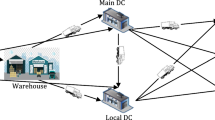Abstract
We study a variant of an abstract scheduling problem inspired by the management of reclaimers in the stockyard of a coal export terminal. We prove NP-completeness of the problem and formulate it as a mixed-integer program. We show that for a given reclaiming sequence, the problem can be solved in pseudo-polynomial time. In addition, we provide simple, constant-factor approximation algorithms as well as exact branch-and-bound algorithms. An extensive computational study analyzes the performance of the algorithms.








Similar content being viewed by others
References
Angelelli, E., Kalinowski, T., Kapoor, R., & Savelsbergh, M. (2015). A reclaimer scheduling problem arising in coal stockyard management. Journal of Scheduling. In press. doi:10.1007/s10951-015-0436-y.
Bierwirth, C., & Meisel, F. (2010). A survey of berth allocation and quay crane scheduling problems in container terminals. European Journal of Operational Research, 202(3), 615–627.
Hu, D., & Yao, Z. (2012). Stacker-reclaimer scheduling in a dry bulk terminal. International Journal of Computer Integrated Manufacturing, 25(11), 1047–1058.
Kim, K., & Kim, K. (1999). A routing algorithm for a single straddle carrier to load export containers onto a containership. International Journal of Production Economics, 59(1), 425–433.
Kim, K., & Kim, K. (2003). Heuristic algorithms for routing yard-side equipment for minimizing loading times in container terminals. Naval Research Logistics (NRL), 50(5), 498–514.
Legato, P., Trunfio, R., & Meisel, F. (2012). Modeling and solving rich quay crane scheduling problems. Computers and Operations Research, 39(9), 2063–2078.
Makarychev, Y. (2014). Another variant of partition. Theoretical Computer Science Stack Exchange. http://cstheory.stackexchange.com/q/22340 (version:2014-04-29).
Ng, W. (2005). Crane scheduling in container yards with inter-crane interference. European Journal of Operational Research, 164(1), 64–78.
Ng, W., & Mak, K. (2005a). An effective heuristic for scheduling a yard crane to handle jobs with different ready times. Engineering Optimization, 37(8), 867–877.
Ng, W., & Mak, K. (2005b). Yard crane scheduling in port container terminals. Applied Mathematical Modelling, 29(3), 263–276.
Sun, D., & Tang, L.(2013). Benders approach for the raw material transportation scheduling problem in steel industry. In 10th IEEE international conference on control and automation (ICCA) (pp. 481–484).
Zhang, C., Wan, Y.-W., Liu, J., & Linn, R. J. (2002). Dynamic crane deployment in container storage yards. Transportation Research Part B: Methodological, 36(6), 537–555.
Author information
Authors and Affiliations
Corresponding author
Appendix: Computational results with \(s = 5\)
Appendix: Computational results with \(s = 5\)
1.1 Exact solution
The results can be found in Tables 4 and 5, in which we report the number of instances solved to optimality, the solution times, and the number of nodes explored.
Figures 9 and 10 compare the runtime of CPLEX, BB1, and BB2 for instances in Class 1 and Class 2, respectively.
1.2 Approximation algorithms
As in Sect. 8.3, we compare the objective function value of the solutions they produce to the value of the objective function of the best solution produced by BB1 in 3600 s. The results can be found in Figs. 11 and 12, where we plot the fraction of instances with a relative gap less than or equal to x, i.e., \((z(\mathbf BB1 ) - z(A))/z(\mathbf BB1 ) \leqslant x\). We also analyze the performance of the three algorithms by comparing them against each other. More specifically, we compare the objective function value of the solutions they produce to \(z(\mathbf best )\), the value of the objective function of the best solution produced for the instance by any of the three algorithms. We plot the fraction of instances with a relative gap less than or equal to x, i.e., \((z(\mathbf best ) - z(A))/z(\mathbf best ) \leqslant x\), in Figs. 13 and 14.
Rights and permissions
About this article
Cite this article
Kalinowski, T., Kapoor, R. & Savelsbergh, M.W.P. Scheduling reclaimers serving a stock pad at a coal terminal. J Sched 20, 85–101 (2017). https://doi.org/10.1007/s10951-016-0495-8
Published:
Issue Date:
DOI: https://doi.org/10.1007/s10951-016-0495-8










